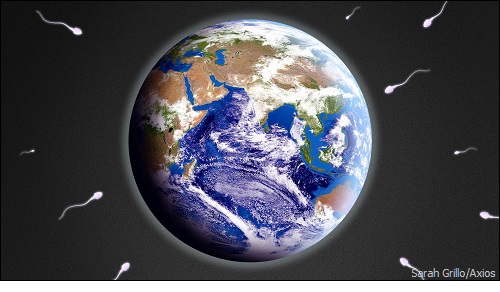
|
|

|
|
| April 25, 2024 |
|
Falling sperm counts could threaten the human race 
A new book makes the case that sperm counts have been falling for decades, and a major reason is chemicals in the environment that disrupt the body's hormonal system.
Why it matters: The ability to reproduce is fundamental to the viable future of any living thing. If certain chemicals are damaging our fertility over the long term, human beings could end up as an endangered species. What's happening: In 2017, Mt. Sinai Medical School epidemiologist Shanna Swan co-authored a sweeping meta-analysis that came to a startling conclusion: Total sperm count in the Western world had fallen 59% between 1973 and 2011. · Together with falling testosterone levels and growing rates of testicular cancer and erectile dysfunction, that translated into a 1% increase per year of adverse reproductive changes for men, according to Swan. Driving the news: Now Swan has written up her conclusions in a new book with a foreboding title: "Count Down: How Our Modern World Is Threatening Sperm Counts, Altering Male and Female Reproductive Development, and Imperiling the Future of the Human Race." · "If you look at the curve on sperm count and project it forward — which is always risky — it reaches zero in 2045," says Swan, meaning the median man would have essentially no viable sperm. "That's a little concerning, to say the least." By the numbers: The global fertility rate — the number of births per woman — has fallen from 5.06 in 1964 to 2.4 in 2018. · Today, about half the countries in the world — including the U.S. — have fertility rates below the population replacement level of 2.1 births. · By 2050, that proportion is projected to rise to two-thirds of nations. Yes, but: There are numerous factors connected to falling fertility rates that appear largely unconnected to sperm counts. · The advent of birth control, the global urbanization shift, changing cultural preferences for smaller families, later in age pregnancy and higher child-raising costs all play a part in most human beings in most places actively deciding to have fewer children. Still, there's a gap around the world between the number of children people say they want and the number they actually have, which indicates at least some of the decline in the fertility rate isn't wholly voluntary. · In her book, Swan points to increasing miscarriage rates and impaired fecundity even among younger women as additional signs there are biological factors at play along with socioeconomic ones. · She notes a rise in boys with clear genital abnormalities, as well as a decline in anogenital distance in infant males and earlier appearance of puberty signs among girls. · These outcomes are related to changes in hormones or endocrines — especially androgens, the sex hormones that drive the development of biologically male characteristics. The big picture: Swan and many of her colleagues point the finger at endocrine-disrupting chemicals in the environment, including phthalates and bisphenol-A, known as "everywhere chemicals" because of their ubiquity in things like plastics, pesticides, cosmetics and even ATM receipts. · "Chemicals in our environment and unhealthy lifestyle practices in our modern world are disrupting our hormonal balance, causing various degrees of reproductive havoc," Swan writes. The other side: As Swan herself notes, there are other factors at play impairing male and female fertility beyond environmental chemicals, including smoking tobacco and marijuana and rising levels of obesity. · The apparent rise in genital abnormalities could be traced in part back to better reporting, and even changes in sperm counts aren't fully certain because there's little in the way of uniform surveillance, especially outside the Western world. · Trade groups — and some scientists — have pushed back against studies that connect endocrine-disrupting chemicals to fertility problems. Our thought bubble: A growing number of scientific institutions have raised the alarm about endocrine-disrupting chemicals, and Swan puts together a strong case that impaired fertility is real and its causes go beyond separate health problems or lifestyle choices. · Swan explicitly compares what she sees as a fertility crisis to climate change, another global threat that has been difficult to combat because its causes are also largely invisible and it unfolds over a long time scale. · Just as CO2 accumulating in the environment over decades adds momentum to climate change, the damage done to human reproduction may be accumulating, with each new generation starting life with increasingly degraded fertility. · She notes that human beings — despite our numbers — arguably already fit three of the five criteria for an endangered species: destruction of our environment, inadequate regulatory mechanisms, and man-made factors that affect our continued existence. The bottom line: "The current state of reproductive affairs can't continue much longer without threatening human survival," Swan writes. (Source: AXIOS) Story Date: February 25, 2021
|